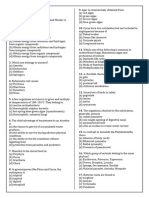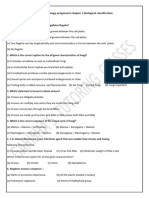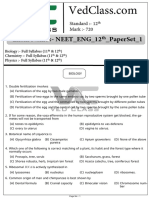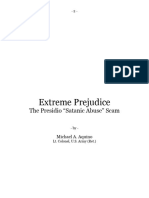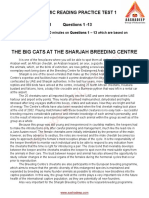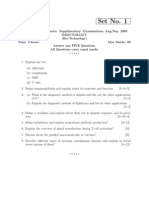0 ratings0% found this document useful (0 votes)
56 viewsBio Botany Unit Test 1
Bio Botany Unit Test 1
Uploaded by
sankarharitha1. The document contains a 65 question quiz about topics related to biology, including viruses, bacteria, fungi, and other microorganisms. Questions cover their classification, structures, life cycles, and roles in diseases and industrial processes.
2. The quiz contains multiple choice, matching, and short answer questions. Questions assess knowledge of key characteristics of different microbes, how they cause diseases, and their applications in food production and other areas.
3. The document is a lesson plan or study guide, with a quiz to test comprehension of important microbiology concepts.
Copyright:
© All Rights Reserved
Available Formats
Download as DOCX, PDF, TXT or read online from Scribd
Bio Botany Unit Test 1
Bio Botany Unit Test 1
Uploaded by
sankarharitha0 ratings0% found this document useful (0 votes)
56 views4 pages1. The document contains a 65 question quiz about topics related to biology, including viruses, bacteria, fungi, and other microorganisms. Questions cover their classification, structures, life cycles, and roles in diseases and industrial processes.
2. The quiz contains multiple choice, matching, and short answer questions. Questions assess knowledge of key characteristics of different microbes, how they cause diseases, and their applications in food production and other areas.
3. The document is a lesson plan or study guide, with a quiz to test comprehension of important microbiology concepts.
Original Title
bio botany unit test 1
Copyright
© © All Rights Reserved
Available Formats
DOCX, PDF, TXT or read online from Scribd
Share this document
Did you find this document useful?
Is this content inappropriate?
1. The document contains a 65 question quiz about topics related to biology, including viruses, bacteria, fungi, and other microorganisms. Questions cover their classification, structures, life cycles, and roles in diseases and industrial processes.
2. The quiz contains multiple choice, matching, and short answer questions. Questions assess knowledge of key characteristics of different microbes, how they cause diseases, and their applications in food production and other areas.
3. The document is a lesson plan or study guide, with a quiz to test comprehension of important microbiology concepts.
Copyright:
© All Rights Reserved
Available Formats
Download as DOCX, PDF, TXT or read online from Scribd
Download as docx, pdf, or txt
0 ratings0% found this document useful (0 votes)
56 views4 pagesBio Botany Unit Test 1
Bio Botany Unit Test 1
Uploaded by
sankarharitha1. The document contains a 65 question quiz about topics related to biology, including viruses, bacteria, fungi, and other microorganisms. Questions cover their classification, structures, life cycles, and roles in diseases and industrial processes.
2. The quiz contains multiple choice, matching, and short answer questions. Questions assess knowledge of key characteristics of different microbes, how they cause diseases, and their applications in food production and other areas.
3. The document is a lesson plan or study guide, with a quiz to test comprehension of important microbiology concepts.
Copyright:
© All Rights Reserved
Available Formats
Download as DOCX, PDF, TXT or read online from Scribd
Download as docx, pdf, or txt
You are on page 1of 4
Achiever’s Maths academy
Lesson -1 :- Bio botany
1)
Which one of the following statement about virus is correct?
(a) Possess their own (b) They are (c) They contain (d) Enzymes
metabolic system facultative DNA or RNA are present
parasites
2)
Identify the incorrect statement about the Gram positive bacteria
(a) Techoic (b) High percentage of (c) Cell wall is (d) Lipopolysaccharide
acid peptidoglycan is found in cell single layered is present in cell wall
absent wall
3)
Identify the Archaebacterium
(a) Acetobacter (b) Erwinia (c) Treponema (d) Methanobacterium
4)
The correct statement regarding Blue green algae is
(a) lack of motile(b) presence of (c) absence of mucilage (d) presence of
structures cellulose in cell wall around the thallus floridean starch
5)
Identify the correctly matched pair
(a) Actinomycete - (b) Mycoplasma - (c) Bacteria - (d) Fungi - Sandal
Late blight Lumpy jaw Crown gall spike
6)
Basidiomycetes do not possess this feature.
(a) Clamp connection(b) Club Fungi(c) Dolipore septum(d) Lack sexual reproduction
7)
A plant growth promoter got from fungi is
(a) Rennet (b) Gibberellin (c) Ergot (d) Griseofulvin
8)
Monotropa derives nutrition by
(a) Root Nodules (b) Lichens (c) Mycorrhizae (d) Roots
9)
are considered as pollution indicators.
(a) Mycorrhiza (b) Actinomycete (c) Lichens (d) Cyanobacteria
10)
Living organisms constitute
(a) Living world (b) Non-living world (c) Animal kingdom (d) Plant kingdom
11)
Living thing is otherwise called as
(a) Organ (b) Organelle (c) Organism (d) Cell
12)
Living things are made of
(a) Organisms (b) Atoms (c) Organs (d) Cells
13)
Sum total of constructive reactions is called as
(a) Anabolism (b) Catabolism (c) Metabolism (d) Embolism
14)
Sum total of destructive reactions is called as .
(a) Metabolism (b) Catabolism (c) Embolism (d) Anabolism
15)
A multicellular organism grows by
(a) budding (b) cell division (c) fission (d) spore formation
16)
Growth in plant is
(a) Diffusable (b) Unlocalized (c) Limited (d) Life long
17)
Organisms grow by
(a) cell division (b) spore formation (c) fragmentation (d) vegetative propagation
18)
Increase in body mass is considered as
(a) cell division (b) homeostasis (c) reproduction (d) growth
19)
do not growth.
(a) Living organisms (b) Microorganisms (c) Dead organisms (d) All the above
20)
multiply and spread very fast by producing millions of asexual spores.
(a) Bacteria (b) Pteridophytes (c) Fungi (d) Sea weeds
21)
Some fungi, filamentous algae and the protonema of mosses multiply by
.
(a) fission (b) fertilization (c) pollination (d) fragmentation
22)
Yeast and Hydra reproduce by
(a) Budding (b) Fission (c) Spore formation (d) Vegetative propagation
23)
is the building block of all living things.
(a) Cells (b) Organs (c) Atoms (d) Compounds
24)
is a basic unit of life.
(a) Atoms (b) Compounds (c) Soils (d) Cell
25)
Earth was formed billion years ago.
(a) 4.6 (b) 5.5 (c) 4 (d) 3
26)
is a sexual method of reproduction.
(a) Binary fission (b) Budding (c) Conidia (d) Gametangial contact
27)
Vaccination for small pox was discovered by
(a) d' Herelle (b) Edward Jenner (c) Robert Gallo (d) F.W. Twort
28)
1 nanometer =
(a) 109 meter (b) 10-9 meters (c) 108 meters (d) 10-6 meters
29)
Size of TMV =
(a) 300 × 200 μm (b) 30 × μm (c) 280 × 150 μm (d) 280 × 40μm
20
30)
Viruses were classified into seven classes by
(a) David Baltimore (b) Twort (c) Ehrenberg (d) Alexopoulos
31)
Identify the criteria not used for classification of viruses.
(a) -ss or -ds (b) Use of RT (c) (+) RNA or (-) RNA (d) Reproduction
32)
A virus with ds DNA.
(a) Pappo viruses (b) Reo viruses (c) Adeno viruses (d) Retro viruses
33)
TMV has a molecular weight of Daltons.
6
(a) 39 × 10 (b) 38 × 105 (c) 39 × 107 (d) 39 × 1010
34)
TMV has approximately capsomeres.
(a) 2030 (b) 2130 (c) 2330 (d) 2000
35)
Match the following:
(1) Toga Virus (a) Mottling
(2) TMV (b) Eater of bacteria
(3) Phage (c) Cauliflower Mosaic Virus
(4) Ribo virus (d) ss RNA
(a) (b) (c) (d)
1234 1234 1234 1234
c dab bc da abc d dabc
36)
Identify the sequence involved in lytic life cycle.
(a) Pinning
(b) Maturation
(c) Synthesis d. Ghost
(a) ABCD (b) ADCB (c) DACB (d) ACDB
37)
Mad cow disease is caused by
(a) Prions (b) Virion (c) Viroid (d) Phage
38)
is considered to be a new kindgom.
(a) Protista (b) Chromista (c) Monera (d)
Plantae
39)
The classification published in recent times was given by
(a) Carlwoese (b) Ruggero et al (c) Whittaker (d)
Copeland
40)
Founder of modern Bacteriology
(a) Koch (b) Griffith (c) Lederberg (d)
Gram
41)
Bacteria was first discovered by a scientist.
(a) German (b) Dutch (c) French (d) American
42)
Identify the correct statement regarding bacterial genome.
(A) Nucleoid
(B) Contains histone
(C) Linear
(D) Absence of nuclear membrane
(a) A and D (b) A and B (c) C and D (d) All the
above
43)
are obligate aerobes.
(a) Streptococcus (b) Clostridium (c) Micrococcus (d)
E. Coli
44)
Griffith demonstrated Transformation in
(a) 1928 (b) 1930 (c) 1975 (d) 1900
45)
Detection of changes in their living place by organisms is called
(a) Interactions (b) Consciousness (c) Autotropic (d)
Meterotropic
46)
are superior among all living things as they have an additional ability
of self-consciousness.
(a) Animals (b) Plants (c) Humans (d)
Monera
47)
Bacteriophage varies in size from
(a) 10-100 nm (b) 1-10 nm (c) 50-500 nm (d) 20-
40 nm
48)
Viruses that cause diseases in fungi are called
(a) Cyanophages (b) Bacteriophages (c) Lactophages (d)
Mycophages
49)
Viruses that attack blue green algae or cyanobacteria and cause diseases are
called
(a) Bacteriophages (b) Cyanophages (c) Mycophages (d)
Lactophages
50)
Virus that infects bacteria is called
(a) Mycophage (b) Lactophage (c) Bacteriophage (d)
Cyanophage
Two marks :-
51)
Differentiate Homoiomerous and Heteromerous lichens.
52)
Write the distinguishing features of Monera.
53)
Why do farmers plant leguminous crops in crop rotations/mixed cropping?
54)
How do living things grow?
55)
What is Homeostasis?
56)
How was the word virus derived?
57)
Name the exceptions in viruses with regard to Nucleic acid.
58)
What is a Prophage?
59)
What are prions?
60)
Name two viral diseases affecting Humans.
61)
Mention any two features of Bacteria.
62)
What are capnophilic bacteria?
63)
Categorise the following based on nutrition.
(a) Chlorobium (b) Iron bacteria
64)
What is retting of fibres?
65)
What is the role of bacteria in production of Tea?
66)
Name the bacteria which causes.
(a) Food Poisoning (b) Plague
67)
What is the unique feature of cell membrane of Archaebacteria?
68)
What is plectenchyma?
69)
What are holocarpic fungi?
70)
What are coprophilic Fungi?
You might also like
- BUMHS MDCAT Past PapersDocument26 pagesBUMHS MDCAT Past Papersfirasahmed171No ratings yet
- BASIC SCIENCE PRACTICE QUESTIONS (Grade 7)Document10 pagesBASIC SCIENCE PRACTICE QUESTIONS (Grade 7)Richard86% (7)
- 7b Oral Health Impact ProfileDocument2 pages7b Oral Health Impact ProfileTria Sesar AprianiNo ratings yet
- NCP - Patient With Chest TubeDocument2 pagesNCP - Patient With Chest TubeSelwynVillamorPatente0% (1)
- Final Bio Botany Material8.8.22emDocument352 pagesFinal Bio Botany Material8.8.22emGAMING WITH STARNo ratings yet
- 327 - 11th Bio-Botany - Unit 1 Study MaterialDocument34 pages327 - 11th Bio-Botany - Unit 1 Study MaterialdeviNo ratings yet
- Neet PCB 3 180Q - 1728870999325Document15 pagesNeet PCB 3 180Q - 1728870999325pearlynNo ratings yet
- Ravi Home Tutions: 1 Maek Test 1Document22 pagesRavi Home Tutions: 1 Maek Test 1Silva scary svNo ratings yet
- Biological Classification + Living World - TESTDocument6 pagesBiological Classification + Living World - TESTsunilsigmaNo ratings yet
- Oss MS00050025Document19 pagesOss MS00050025milapdhruvcomputerworkNo ratings yet
- 03-NEET11 DinLW, BC - 08-07-2024 - M1Document3 pages03-NEET11 DinLW, BC - 08-07-2024 - M1KISHAN R GOWDANo ratings yet
- Biological: ClassificationDocument5 pagesBiological: Classificationgnew61438No ratings yet
- Bio 101 Questions CGMDocument2 pagesBio 101 Questions CGMbeulahhub0No ratings yet
- Biology Assignment XI Ch-2 Biological ClassificationDocument9 pagesBiology Assignment XI Ch-2 Biological ClassificationPoonam MeenaNo ratings yet
- 2nd Class TestDocument2 pages2nd Class TestMinahil KhalidNo ratings yet
- 11 Bio McqsDocument8 pages11 Bio McqsToqeer HaiderNo ratings yet
- Oss MS00060024Document19 pagesOss MS00060024milapdhruvcomputerworkNo ratings yet
- Biological ClasificationDocument3 pagesBiological Clasificationfocuscoachingcentre222No ratings yet
- Class 11 Biology Assignment Chapter 2 Biological ClassificationDocument6 pagesClass 11 Biology Assignment Chapter 2 Biological ClassificationGarisha VirdiNo ratings yet
- 1st Year Biology Guess Paper 2024 (MCQS)Document32 pages1st Year Biology Guess Paper 2024 (MCQS)Muhammad RamzanNo ratings yet
- Bio3 3Document4 pagesBio3 3israelinioluwaNo ratings yet
- Oss MS00010028Document20 pagesOss MS00010028milapdhruvcomputerworkNo ratings yet
- Biological - ClassDocument15 pagesBiological - ClassSai Shri Harshit DNo ratings yet
- DPS Revision Offline Test - 1: Based On DPS 1 To DPS 30Document16 pagesDPS Revision Offline Test - 1: Based On DPS 1 To DPS 30Savitri HegdeNo ratings yet
- M 8 Bs RZT Yskp QO3 Uh MDRLDocument8 pagesM 8 Bs RZT Yskp QO3 Uh MDRLasterclixNo ratings yet
- Biology Practice Sheet Teacher Concerned: A.G ArijoDocument2 pagesBiology Practice Sheet Teacher Concerned: A.G ArijoSmart MemonNo ratings yet
- 1stTermExamination D06 Oct 2022Document8 pages1stTermExamination D06 Oct 2022GALAXY GROUP SCIENCENo ratings yet
- Biology Test - 1Document3 pagesBiology Test - 1Mr shaikhNo ratings yet
- Ayesha Neet Paper Sunday BiologyDocument8 pagesAyesha Neet Paper Sunday BiologySUP DOCNo ratings yet
- Biology Key Answers 2022Document6 pagesBiology Key Answers 2022MAHATHMA GANDINo ratings yet
- Biology MCQDocument60 pagesBiology MCQpullaiNo ratings yet
- Biology Assignment-2 MVPPDocument3 pagesBiology Assignment-2 MVPPvishavjeetsinghmodgilNo ratings yet
- Oss MS00080022Document19 pagesOss MS00080022milapdhruvcomputerworkNo ratings yet
- PARAGON ACADEMY Full Book Mcqs KEYDocument2 pagesPARAGON ACADEMY Full Book Mcqs KEYMuhammad BootaNo ratings yet
- Class 7 BiologyDocument3 pagesClass 7 Biology09whitedevil90No ratings yet
- Botany Neet ModelDocument1 pageBotany Neet ModelEbanNo ratings yet
- Test 2Document1 pageTest 2abhijeet_sangwanNo ratings yet
- PM Model Exam Set-VII (2079!5!25) (Q)Document8 pagesPM Model Exam Set-VII (2079!5!25) (Q)Darpan AdhikariNo ratings yet
- Cell - DPPDocument8 pagesCell - DPPAditya RautwadNo ratings yet
- Biological Classification SNS 02 (Chapter Wise Test) - 1375 - 1723075464986Document7 pagesBiological Classification SNS 02 (Chapter Wise Test) - 1375 - 1723075464986surajsinghpahi2024No ratings yet
- Class XII ZOOLOGY Warm Up Test Sir Salman HussainDocument2 pagesClass XII ZOOLOGY Warm Up Test Sir Salman HussainFarid AhmedNo ratings yet
- 270 SciDocument8 pages270 SciprajwaladuganiNo ratings yet
- YVEX8d587jbMbhWKb4DW 230519 232428Document7 pagesYVEX8d587jbMbhWKb4DW 230519 232428ry364970No ratings yet
- Exam Name:-Neet - Eng - 12 - Paperset - 1: Standard: - 12 Mark: - 720Document21 pagesExam Name:-Neet - Eng - 12 - Paperset - 1: Standard: - 12 Mark: - 720KalyaniNo ratings yet
- 11th Biology One Mark Question Bank With Answer EMDocument39 pages11th Biology One Mark Question Bank With Answer EMKAMATCHI SCHOOLNo ratings yet
- 10th Science 20-02-2022Document4 pages10th Science 20-02-2022adityasharma6261srNo ratings yet
- Biology mcqs for FPSC PPSCDocument21 pagesBiology mcqs for FPSC PPSCHamad VistroNo ratings yet
- KOOOLDocument5 pagesKOOOLAkachinedum NwaoguNo ratings yet
- Chapter 02 Biological Classification ADocument7 pagesChapter 02 Biological Classification AhsrgnNo ratings yet
- 12th Biology Interior One Mark TestDocument37 pages12th Biology Interior One Mark TestvideoconsrihariNo ratings yet
- SSC General Studies - Cracker (WWW - Qmaths.in)Document135 pagesSSC General Studies - Cracker (WWW - Qmaths.in)Shubhra MathurNo ratings yet
- Biological Classification BDocument6 pagesBiological Classification BAnup K50% (2)
- I. Choose The Correct Answer: Do at ClassDocument9 pagesI. Choose The Correct Answer: Do at ClassNishali SamNo ratings yet
- Oss MS00070023Document18 pagesOss MS00070023milapdhruvcomputerworkNo ratings yet
- Biology CHP 1 To CHP 5 Multiple Choice Questions (MCQ'S)Document9 pagesBiology CHP 1 To CHP 5 Multiple Choice Questions (MCQ'S)Usman RiazNo ratings yet
- General-Science-Model-Test-Questions-2-in-English-With-AnswerDocument11 pagesGeneral-Science-Model-Test-Questions-2-in-English-With-Answerrockybhai212f79a358i8wNo ratings yet
- 2 Biological Classification.Document4 pages2 Biological Classification.Vishesh GoyalNo ratings yet
- 1.1. The Living WorldDocument4 pages1.1. The Living Worldjohnny100% (1)
- 12TH AGRI PREVIOUS PAPER 5Document12 pages12TH AGRI PREVIOUS PAPER 5ankityadav46266No ratings yet
- What Bugged the Dinosaurs?: Insects, Disease, and Death in the CretaceousFrom EverandWhat Bugged the Dinosaurs?: Insects, Disease, and Death in the CretaceousRating: 3 out of 5 stars3/5 (3)
- O Level Biology Practice Questions And Answers: Ecology And Our Impact On The EcosystemFrom EverandO Level Biology Practice Questions And Answers: Ecology And Our Impact On The EcosystemNo ratings yet
- Extreme Prejudice - The Presidio - Michael A. AquinoDocument715 pagesExtreme Prejudice - The Presidio - Michael A. AquinoKyle LumsdenNo ratings yet
- Morphology of COVID-19-affected Cells in Peripheral Blood FilmDocument2 pagesMorphology of COVID-19-affected Cells in Peripheral Blood FilmAsu KaraNo ratings yet
- MICROBIOLOGY 2020-2010 (Regular) Topic Wise Question Papers WBUHS © Medical JunctionDocument10 pagesMICROBIOLOGY 2020-2010 (Regular) Topic Wise Question Papers WBUHS © Medical JunctionAbhra ChowdhuryNo ratings yet
- Eodd 20Document118 pagesEodd 203500amd7742100% (1)
- Poultry ButcheryDocument110 pagesPoultry ButcheryBernard PalmerNo ratings yet
- Patterns of Tooth MovementDocument6 pagesPatterns of Tooth MovementAshish DeotaleNo ratings yet
- CHN Lec Activity 2Document3 pagesCHN Lec Activity 2RickNo ratings yet
- Ielts Fever-Academic-Reading-Practice-Test-1 PDFDocument11 pagesIelts Fever-Academic-Reading-Practice-Test-1 PDFchandaNo ratings yet
- 7 Digestive SystemDocument64 pages7 Digestive SystemARra OdezaNo ratings yet
- Abo Blood Group SystemDocument17 pagesAbo Blood Group SystemCSC LanjipadarNo ratings yet
- Introduction To ParasitologyDocument9 pagesIntroduction To Parasitologysarguss14No ratings yet
- Adult Client With Cardiovascular DisorderDocument14 pagesAdult Client With Cardiovascular Disordergraphicsbydi4mondNo ratings yet
- ANA213 - Urinary System - AY2020-2021 PDFDocument42 pagesANA213 - Urinary System - AY2020-2021 PDFSairelle Sordilla ObangNo ratings yet
- Thesis 2Document67 pagesThesis 2Kishenthi KerisnanNo ratings yet
- The ElectrocardiogramDocument53 pagesThe ElectrocardiogramJEM93No ratings yet
- Six Essential Factors For The Development of The Infectious ProcessDocument2 pagesSix Essential Factors For The Development of The Infectious ProcessJohn Balisong100% (1)
- Repair Part 1Document6 pagesRepair Part 1ماجد احمدNo ratings yet
- Astrid GrgurichDocument11 pagesAstrid Grgurichaqsa imranNo ratings yet
- Cholinergic DrugsDocument30 pagesCholinergic DrugsDrShweta SainiNo ratings yet
- Case Study of NioshDocument3 pagesCase Study of NioshNur Hadirah Afiqah Binti Abdul RazakNo ratings yet
- Antimicrobial Susceptibility Testing: A Review of General Principles and Contemporary PracticesDocument7 pagesAntimicrobial Susceptibility Testing: A Review of General Principles and Contemporary Practicesabhishek yadavNo ratings yet
- Safety Data Sheet: Red Head® C6+, Part ADocument14 pagesSafety Data Sheet: Red Head® C6+, Part Ajulio villanuevaNo ratings yet
- PertussisDocument11 pagesPertussissribaccayNo ratings yet
- Mango Malformation TreatmentDocument2 pagesMango Malformation TreatmentShabbir HussainNo ratings yet
- rr322305 ImmunologyDocument4 pagesrr322305 ImmunologySRINIVASA RAO GANTANo ratings yet
- 11 NS SonopodDocument5 pages11 NS SonopodCarol Artigas GómezNo ratings yet
- PTERYGIUMDocument33 pagesPTERYGIUMdiana0% (1)
- 3rd Internal 2020 Batch (2nd Year)Document5 pages3rd Internal 2020 Batch (2nd Year)Trisha NishantNo ratings yet









